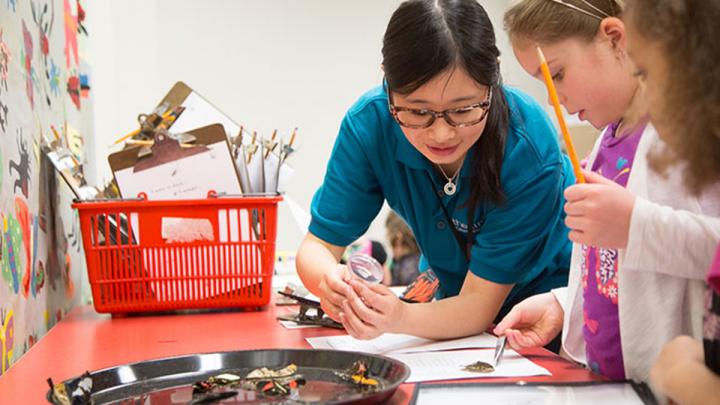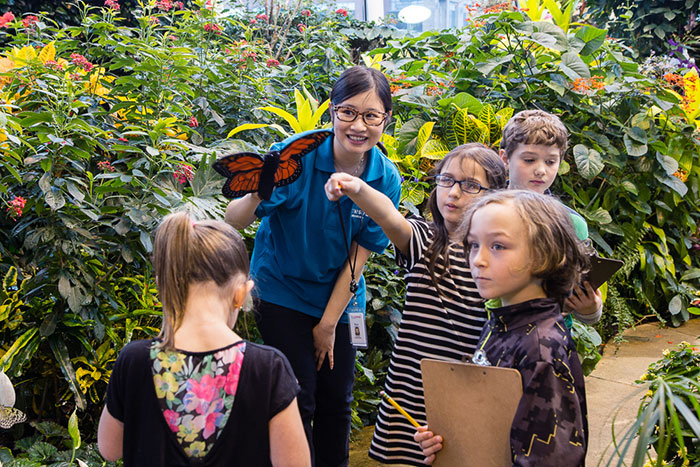
Warner student helps transform, pilot new butterfly garden lessons online
When Ella Wan attended primary school in the city of Chengdu in China, teachers stood in front of a class of children, serving as the central source of knowledge for all students.
“I grew up with a very teacher-centered classroom, where didactic pedagogy dominated the class,” said Wan, whose Chinese first name is Xiaoyu. “Students often guessed at the answers to satisfy the teacher.”
Today, Wan, a graduate student in teaching and curriculum and the certificate in online teaching program at the Warner School, is part of a digital revolution in K-12 education—a transformation to online teaching and learning that fosters a more student-centered and student-directed learning experience. It’s an approach that allows students to take on more ownership in the classroom.
Upon completing the two core courses for the certificate in online teaching and learning, Wan took her entrepreneurial spirit to The Strong National Museum of Play (The Strong), where she presented the idea of transforming the museum’s face-to-face lessons into online lessons as part of her practicum. Shortly after connecting with The Strong’s Director of Education Debbie McCoy and discussing the museum’s goals, Wan was eager to help the museum reach more students in the classroom, who may not otherwise have a chance to regularly visit the museum, by providing opportunities for them to enjoy the richness and resources of the museum online as part of their school experience.
“I was so intrigued with how adults and kids played together, interacted, and engaged in exploration at the museum,” said Wan, reflecting back to her very first trip to the museum prior to working on this project. “Contrary, I’ve also witnessed through my teaching placements how students are losing more and more interest in learning in the classroom.” These two observations combined gave Wan hope and determination to transform a unit that captured the museum’s mission of learning through play and inquiry learning in an online format that makes it more accessible to schools.
As part of her internship this semester, Wan redesigned and converted the museum’s traditional Butterfly Garden Program lessons into an online format that she then taught remotely from the museum to nearly 50 first-grade students at East Irondequoit Helendale Road Primary School.
“The big ideas that are in keeping with The Strong’s educational philosophy that we wanted to carry over into an online format were for students to understand what it means to be a scientist,” explained McCoy, “and for students to experience true inquiry and learn how to pursue good open-ended questions, like ‘How does a butterfly get to be a butterfly?’ that typically lead to more questions.”
During March and April, Wan delivered the following two synchronous online sessions through Skype: “The Very Hungry Caterpillar,” a lesson accessing information from both non-fictional and fictional texts, and “How to Avoid Being Dinner,” a lesson on predator/prey defense mechanisms. Additionally, she delivered an asynchronous session on the butterfly lifecycle, called “Waiting for Butterfly,” through the learning-management system Schoology. A fourth and final lesson, “Dancing Butterfly Garden,” then brought first-graders on a field trip to The Strong for further research and self-exploration as scientists.
 On April 9, the two first-grade classes loaded the bus and headed over to The Strong for their culminating butterfly lesson. With the task of becoming scientists, each student arrived that morning with a question that he or she wanted to research and answer. Questions ranged from “How do butterfly wings make butterflies fly? and “How many butterfly species are in the world?” to “How high can a butterfly fly” and “Where do butterflies migrate?”
On April 9, the two first-grade classes loaded the bus and headed over to The Strong for their culminating butterfly lesson. With the task of becoming scientists, each student arrived that morning with a question that he or she wanted to research and answer. Questions ranged from “How do butterfly wings make butterflies fly? and “How many butterfly species are in the world?” to “How high can a butterfly fly” and “Where do butterflies migrate?”
The Butterfly Garden Program was a first attempt for East Irondequoit teachers and students to get their feet wet with online learning in a K-12 classroom setting. And, these first-grade students benefited from this new online learning experience.
“They have engaged in real inquiry and built great background knowledge of the content through critical thinking, asking questions, and pursuing answers,” McCoy added. “It’s provided us multiple interactions with the same classes. Rather than coming to the museum once, it’s allowed us to have involvement in the entire unit and help students to become scientists.”
It was also the museum’s goal, McCoy explained, to have teachers be researchers alongside children. Wan also worked closely with East Irondequoit first-grade teachers, like Danielle McRae, to ensure that activities and lessons were age-appropriate—a challenge Wan initially faced but later solved through this ongoing interaction and communication with teachers.
McRae, who closely observed and assisted her class throughout these online lessons, said that this experience has helped her students to gain a whole new appreciation for butterflies and an understanding of them. “We’ve done lessons on butterflies in the past, but they are now asking better questions—more inquiry-based questions,” McRae said. “It was something new and exciting for students. The kids loved it.”
With the museum’s format of the Butterfly Garden Program, students are able to have authority and autonomy in leading conversations in the classroom as well as navigating and interacting with technology, Wan explained. Students are able to act as scientists by posting their own questions online and conducting their own research with the support of group members, chaperons and book resources—and they were even able to design their own butterflies.
In addition to honing students’ skills as scientists, the series of new online butterfly lessons were designed to foster their literacy skills.
Wan added, “My goal was to make this fun, easy, and simple for students and to create a scientific inquiry environment that also brought in the non-fiction focus as required by the Common Core State Standards. I wanted the whole experience to be fun for them.”